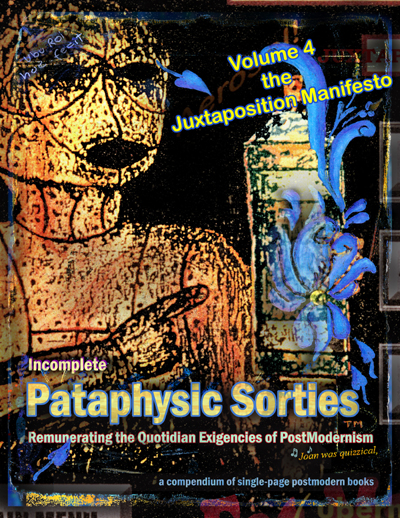
Pataphysic Sorties
Volume Four
The Juxtaposition Manifesto
 While the New Historicism arrogates the look and feel of the traditional apotropaic quotidian in a well-meaning effort to render the barbarian aesthetic and the machine metaphor, as well as post-Freudian historical analysis and its less palpable object, vulnerable to a consentual self-investigation, the ostensible nexus of such solipsistic inquiry must be ipso-facto (no pun intended) a circular enterprise, and thus must be understood to be capable of yielding only self-signifying, Postmodern conundra; i.e. a singularly isomorphic misapplication of Heisenberg to macro-phenomena.
While the New Historicism arrogates the look and feel of the traditional apotropaic quotidian in a well-meaning effort to render the barbarian aesthetic and the machine metaphor, as well as post-Freudian historical analysis and its less palpable object, vulnerable to a consentual self-investigation, the ostensible nexus of such solipsistic inquiry must be ipso-facto (no pun intended) a circular enterprise, and thus must be understood to be capable of yielding only self-signifying, Postmodern conundra; i.e. a singularly isomorphic misapplication of Heisenberg to macro-phenomena.
The Greek discovery of sculptural contrapposto (engaged leg vs. disengaged leg), around the time of the Battle of Marathon, was a revolution in human artifice. Suddenly sculptural bodies were actual simulacra, posing twisted and gravitationally balanced, bone for bone muscle for muscle, like real humans in three dimensions. It was a palpable recognition of how opposing parts and forces work symbiotically in the world.

Of course it mirrored and reflected the contemporary neo-dualistic structures developing at the time in Greek philosophy and science. Together these elements of "Hellenic Dualism" have defined Western culture for the past two and a half millennia. At the end of the Nineteenth Century, the Post-Impressionist painter Paul Gaugin typified a huge cultural movement against this ancient Greek philosophical and artistic influence. Gaugin, along with a respectable percentage of contemporary literati, artists, and even scientists, proposed that not only we should break ourselves free of Western culture's isomorphic rationalism, but that it had been a mistake for the Greeks to fall under the spell of their dualistic contrapposto in the first place, twenty four hundred years prior.
 From the inception of what Gaugin referred to as "the Greek mistake" a philosophical as well as physical contrapposto, attesting the radical dualism promulgated by the enduring Greek cult of the individual, has fostered through the centuries, a structural bias to the contrapositive. The embedded problem of mechanism's ultimate dominance indexes irremediably to the moment the Greeks’ first marble kouros achieved a new ground in severity and engaged a single leg. Is it possible then, one might ask, that Western duality's inherent but unacknowledged proscription would still necessarily prevent a Postmodern Demosthenes from raising up his lantern to a mirror?
From the inception of what Gaugin referred to as "the Greek mistake" a philosophical as well as physical contrapposto, attesting the radical dualism promulgated by the enduring Greek cult of the individual, has fostered through the centuries, a structural bias to the contrapositive. The embedded problem of mechanism's ultimate dominance indexes irremediably to the moment the Greeks’ first marble kouros achieved a new ground in severity and engaged a single leg. Is it possible then, one might ask, that Western duality's inherent but unacknowledged proscription would still necessarily prevent a Postmodern Demosthenes from raising up his lantern to a mirror?

THIS BOOK IS CURRENTLY UNAVAILABLE